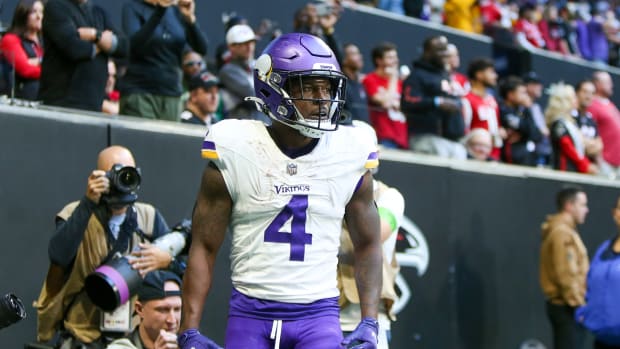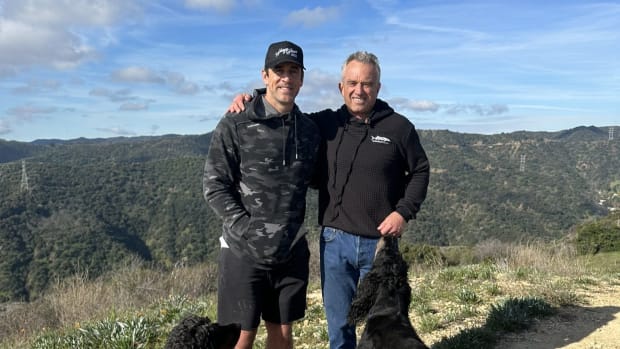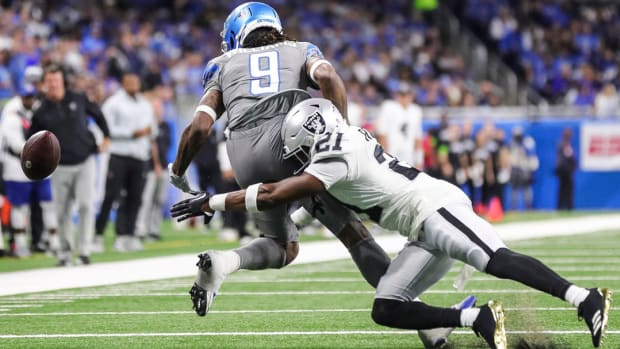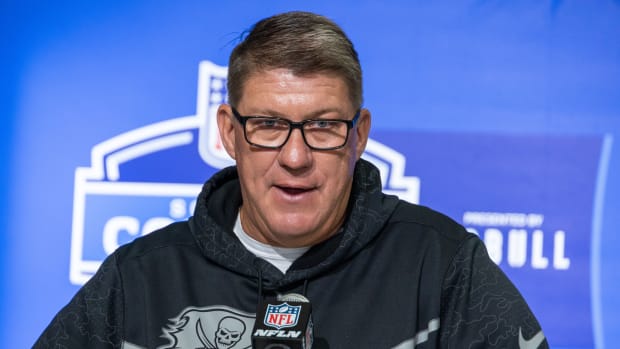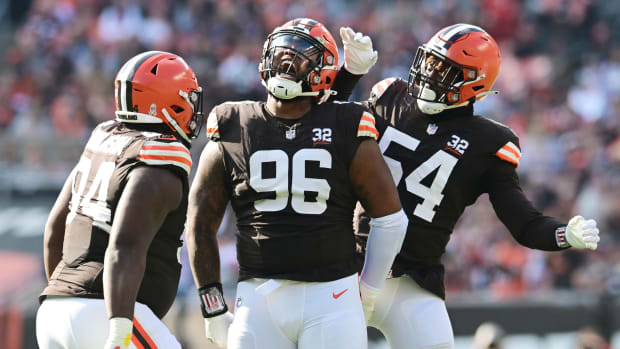Wide Receiver Fantasy Rankings
In the early days of fantasy football, we scored by hand. Literally, you would check the morning paper, prick the top of the pinky finger of your dominant hand, then scrawl your score in blood on the walls of your opponents’ home. Later, there were yellow wooden tubes containing lead and graphite called pencils. At first, pencils were celebrated as more hygienic and safer than human blood (or any other bodily fluid, for that matter). But, of course, there were complications due to the Pencil Wars of 1991 (No. 2 forever!), but that’s a long, winding, fictional story that goes nowhere for another day.
Fast forward to the late-’90s and things that actually happened, when Sportsline rolled out a league manager (soon to be followed by Yahoo, whose league manager was free, because it’s in the Constitution—somewhere towards the bottom—that no one ever has to pay for anything on the internet) to eliminate the need for a commissioner with basic management skills and an understanding of third-grade mathematics. In… someone’s infinite wisdom, it was decided that the fantasy football postseason would take place at the end of the regular season. I get why: It was and is the easy (and lazy) solution. Of course, it was also the dumbest. You’re going to have one-and-done playoff games during the time of season when (a) there are the most injuries, (b) the best teams (with, presumably, some of the best fantasy players) are often resting starters, and (c) the holidays are going on, so everyone’s paying the least amount of attention to football that they possibly can. Those are the most important weeks of the fantasy season?
Your fantasy playoffs should take place during the NFL playoffs. Here’s how it works (for any league size):
• The regular season runs until Week 16 (Week 17 is a throwaway week for too many NFL teams, ignore it). You end up with a 16-game record, just like they have in the NFL. Neat!
• There is a “draft” for each round of the NFL playoffs (though Super Bowl is optional, more on that later). The top six regular-season teams advance to the playoffs, with the top two getting first-round byes. That way the player pool approximately matches the regular-season player pool, as four fantasy teams will draft from a pool of eight NFL teams in the first two rounds, and two will draft from a pool of four NFL teams during the conference title games.
• The player pool is anyone playing in that round. There is no carryover from regular-season rosters (otherwise, good luck trying to project the No. 3 seed in each league in August), or from one postseason round to the next.
• You can either match up (1 vs. 4, 2 vs. 3) or just say top two scores advance to the next round. Each owner drafts a starting lineup only (no need for a bench, since it’s only your lineup for one week). Think of it as playing DFS.
• The advantage of being the highest seed? You draft first in every round. Second-seeded team drafts second in every round, third-seeded team third, fourth-seeded team last in every round. The higher your seed, the bigger your edge. That’s a much better reward for regular-season success than a fluky one-week matchup in December.
• Four teams are alive for the divisional round, then two are left for the final (I recommend making conference-title Sunday the final, but it’s up to you. I’ve had some owners in the final decide they want to make it a two-week extravaganza and draft again for the Super Bowl.)
• This system is not only a more suitable reward for regular-season success, but it keeps more teams in your league in playoff competition deeper into the season.
The complaints I’ve heard about this system:
• You have to score it by hand (at least until Yahoo or ESPN or Sportsline catches on). So someone in your league has to have a licensed version of Microsoft Excel or know addition, multiplication and division.
• Some can’t bear to part ways with players they owned during the regular season. I’m never quite sure if I find an emotional attachment to strangers you “own” in a make-believe sports league to be endearing or disturbing. But, as I tell owners who make that complaint in my leagues: Sit down and pen a nice thank-you note to each player on your regular-season roster. It’s cathartic, even if it might result in a restraining order.
• “I don’t want to be playing fantasy football in January.” Uh, OK. Though after four months of fantasy football that’s an odd place to draw the line.
The fact is, if this was how the fantasy football postseason was drawn up in the ’90s, and someone in your league suggested that you just move the semis to Week 15 and the final to Week 16, you would laugh in that person’s face and, if not shiv them with the sharpest item within reach, at least insult that person’s mother.
With that, let’s go to the rankings…
• MORE FANTASY RANKINGS:QUARTERBACKS | RUNNING BACKS
* * *
1. Antonio Brown, Pittsburgh
The No. 1 overall player in fantasy football. With Martavis Bryant suspended for the year and Le’Veon Bell (probably) out for the first four games, everything is coming Brown’s way.
2. Odell Beckham Jr., N.Y. Giants
The gap between Beckham and the Giants’ second-best non-QB skill position player is immeasurable. And he is Eli Manning’s everything in the red zone.
3. Julio Jones, Atlanta
Julio Jones might be the most gifted wide receiver in football. But here’s the weird thing: He’s never scored many touchdowns. He has had double-digit TDs in a season only once, when he had exactly 10 in 2012. He is second among all receivers in catches and receiving yardage over the past two seasons (behind only Antonio Brown). And yet, he’s only tied for 23rd in touchdown catches during that span (with 14). He has as many touchdowns over the past two seasons as James Jones, and fewer than Torrey Smith and Jordan Frickin’ Matthews. And Julio Jones has only caught seven red-zone TDs over the past two years, the same number as John Brown, the Cardinals’ 4-foot-7-inch receiver. I asked my colleague and podcast partner (and therefore best friend) Andy Benoit why Jones, with his physical tools, is not an absolute monster in the red zone. Andy said he didn’t know, but he’d ask the next time he talks to Falcons coaches. I’m not sure when that’s going to be, but I’ll put the answer right here when I get it. In the meantime, I’d suggest refreshing this page every 40 seconds or so indefinitely.
4. Brandon Marshall, N.Y. Jets
It’s one thing to put up big numbers. But Marshall was almost upsettingly consistent last year. Ryan Fitzpatrick (he signed!) targeted him at least seven times in every game, and Marshall had either 60 yards or a touchdown in every game (including 10 100-yard games).
5. Dez Bryant, Dallas
Yes, throw last season out, but also be terrified by Tony Romo’s increasing fragility. Romo-to-Bryant is the best red-zone combination in football, but that QB depth chart in Dallas… avert your eyes, children.
6. DeAndre Hopkins, Houston
The fact that Hopkins produced the kind of numbers he did last year is mind-blowing; were I an opposing defensive coordinator facing the Texans, I would have rushed three and then had my other eight hold hands and form a circle around Hopkins. The Texans may not have added tremendously talented receivers around him, but at least they added fast ones in rookies Will Fuller and Braxton Miller. Safeties will have to respect the speed, and Hopkins will have more room to work with. And while the jury is out on Brock Osweiler, he’s better than what Houston ran out last year.
7. Alshon Jeffery, Chicago
Compared to opposing defensive backs, Jeffery looks like the kid in Pop Warner who hit puberty way too early. He’s physically dominant, and he has great chemistry with Jay Cutler. It’s just a question of how many games he plays. If it’s 16, he’ll be a top-five, maybe top-three fantasy receiver.
8. Mike Evans, Tampa Bay
The guy might have hands like feet, but Evans’ size and strength makes him literally unguardable most of the time, and he’s obviously a favorite of Jameis Winston’s.
9. A.J. Green, Cincinnati
He presumably will take a bigger share of targets with Marvin Jones and Mohamed Sanu gone and Tyler Eifert sidelined for a while. The latter is the big one, as Green has taken a back seat to Eifert in the red zone.
10. Keenan Allen, San Diego
He was on pace to be the seventh-highest scorer among fantasy receivers before he missed the second half of the season with a lacerated kidney (soft). I think Travis Benjamin will siphon a few targets from him, but Allen figures to be a consistent WR1 playing on a team with a great quarterback and a feeble running game.
11. Jordy Nelson, Green Bay
You get the feeling that if Nelson is missing multiple limbs by Labor Day the Packers will still figure out a way to get him on the field for Week 1, so it’s tough to project whether or not he’ll be healthy for the start of the season. He’s a top-10 fantasy receiver if he’s 100% a go for Week 1.
12. Allen Robinson, Jacksonville
Robinson was great a year ago. But two things: As I mentioned in my Blake Bortles write up, the Jaguars threw a league-leading 23 second half/OT TDs last season in large part because the Jaguars gave up more first-half points than any other team in football. Assuming the D makes even a fraction of the improvement most of us are expecting, Robinson’s numbers will take a hit. And on top of that, Robinson led the NFL in red-zone TD catches last season, but Jacksonville upgraded their short-field rushing attack by adding Chris Ivory. It all adds up to a statistical step back for Robinson.
13. Doug Baldwin, Seattle
The Seahawks went to a revamped spread, timing-based passing attack late last year, and Baldwin delivered 34 catches for 530 yards and an absurd 11 touchdowns over six post-Thanksgiving games. The return of Jimmy Graham likely cuts into some of his red-zone looks, but Baldwin is still teed up for a very big year in an increasingly pass-happy offense.
14. Sammy Watkins, Buffalo
He’s so good when he’s on the field, good enough to put up big numbers even in a run-heavy Bills offense.
15. Brandin Cooks, New Orleans
As Drew Brees’ arm strength continues to dwindle, Cooks and his catch-and-run skills will become a larger part of the Saints’ offense.
16. T.Y. Hilton, Indianapolis
Keep at least one foot on the Andrew Luck bandwagon. Hilton is the biggest benefactor of his return, and the Colts are going to throw it a ton.
17. Amari Cooper, Oakland
This is the year Carr-to-Cooper takes off.
18. Larry Fitzgerald, Arizona
On one hand, this feels a little low considering what Fitzgerald did last year. On the other hand, it seems a little high considering Fitzgerald will be 33 years old when the season begins.
19. Julian Edelman, New England
He’s coming off two foot surgeries, which is troubling considering he runs on those things. A healthy Edelman is a borderline top-10 guy considering his growing role in the red zone.
20. Donte Moncrief, Indianapolis
Get all the Colts! Moncrief is primed for a breakout year. He showed flashes of it early last season, showing improved chemistry with Andrew Luck, and his size makes him an obvious red-zone target on a team that lacks the running game to punch it in down there.
21. Demaryius Thomas, Denver
So… maybe just direct snap it to Thomas 28 or so times every week?
22. Jarvis Landry, Miami
I like a good possession receiver as much as the next guy, but Landry is probably not going to score touchdowns (a Davante Adams-like four catches on 14 targets inside opponents’ 10-yard line last year). And he’s probably going to have DeVante Parker cut into his targets.
23. Randall Cobb, Green Bay
Hopefully the return of Jordy Nelson restores order in Wisconsin, where Cobb should have more room to work.
24. Eric Decker, N.Y. Jets
He was an unlikely red-zone monster last year. Decker was targeted inside opponents’ 20- and 10-yard lines (28 and 16 times, respectively) more often than any other receiver in the NFL in 2015.
25. Kelvin Benjamin, Carolina
The Panthers are likely going to spread the wealth more than they did when Benjamin was a rookie. Still, he’s their best downfield threat and best red-zone target, and Carolina is going to put up points.
26. Jeremy Maclin, Kansas City
With Alex Smith as his quarterback in an Andy Reid offense, Maclin should be as consistent as any receiver, even if his ceiling isn’t particularly high. But, hey, after the Chiefs went 47 years without a wide receiver scoring a touchdown, Maclin scored six over the last six regular-season games of 2015.
27. DeVante Parker, Miami
You saw what Demaryius Thomas did under Adam Gase in Denver, and ditto Alshon Jeffery in Chicago, and Parker will be Gase’s most physically gifted receiver in Miami. If you Google the term “DeVante Parker looks great in practice,” it will turn up about 53,000,000 hits. (Don’t actually do it, that was a joke.)
28. Golden Tate, Detroit
The Calvin Johnson retirement elevates Tate to No. 1 receiver in a pass-first offense. Though between last year’s 9.0 yards-per-catch average and the fact that he’s never scored more than seven touchdowns in a season, titillating he is not.
29. Emmanuel Sanders, Denver
Paxton Lynch can’t be developed fast enough.
30. Kevin White, Chicago
He’s exactly the kind of big-bodied receiver Jay Cutler loves, and if Alshon Jeffery can’t stay on the field for 16 games, White could be in for a big first season.
31. John Brown, Arizona
Brown has a bit of that Joey Galloway Syndrome; he can blow up or get shut out in any given week. But then, he’s the top deep threat on an offense that’s predicated on chucking it deep.
32. Travis Benjamin, San Diego
He’s the best deep threat Philip Rivers has had since Vincent Jackson. Though as primarily a deep threat (and a third option to boot), Benjamin’s numbers will likely fluctuate on a week-to-week basis. But as long as the Chargers struggle to run the ball, the potential reward is enormous.
33. Jordan Matthews, Philadelphia
I dunno. Matthews is the best of a pretty crappy group of skill-position guys in Philly. He fell just short of 1,000 yards last year, and I guess that sounds about right for this season.
34. Marvin Jones, Detroit
Matthew Stafford can throw the ball far, and Jones is the best deep threat on Detroit’s roster.
35. Steve Smith Sr., Baltimore
I’d love to believe he could pick up where he left off last season, but he’s 37 and coming off a ruptured Achilles.
36. Allen Hurns, Jacksonville
Just like Allen Robinson: The Jaguars will likely throw it less overall, and especially in the red zone.
37. Michael Crabtree, Oakland
He had a very nice bounce-back year as Derek Carr’s security blanket, but Crabtree’s fantasy value is on the brink as Amari Cooper’s star rises.
38. Phillip Dorsett, Indianapolis
He might be a year or two away from a true breakout, but the Colts are going to run a lot of three-wide, and the offense is going to be built around the deep ball. It’s all good news for Dorsett.
39. Tyler Lockett, Seattle
Yes, we’re all excited about Lockett, but keep in mind: Jimmy Graham is back, and after Doug Baldwin’s late-season explosion Lockett is the third option in an offense that’s skewing more pass-heavy, but isn’t exactly fun ’n’ gun.
40. Tavon Austin, Los Angeles
He’ll be the focal point of the passing game for a team that won’t pass it often. Though Austin is the only playmaker L.A. has in the receiving corps, so he’ll get his touches.
* * *
Other humans good enough to consider drafting, but not good enough for me to write about…
41. Sterling Shepard, N.Y. Giants
42. Josh Gordon, Cleveland
43. Dorial Green-Beckham, Tennessee
44. DeSean Jackson, Washington
45. Corey Coleman, Cleveland
46. Markus Wheaton, Pittsburgh
47. Torrey Smith, San Francisco
48. Willie Snead, New Orleans
49. Michael Floyd, Arizona
50. Michael Thomas, New Orleans
51. Vincent Jackson, Tampa Bay
52. Mohamed Sanu, Atlanta
53. Stefon Diggs, Minnesota
54. Kamar Aiken, Baltimore
55. Laquon Treadwell, Minnesota
56. Sammie Coates, Pittsburgh
57. Ted Ginn, Carolina
58. Kendall Wright, Tennessee
59. Rishard Matthews, Tennessee
60. Chris Hogan, New England
61. Pierre Garçon, Washington
62. Mike Wallace, Baltimore
63. Will Fuller, Houston
64. Josh Doctson, Washington
65. Andrew Hawkins, Cleveland
66. Stevie Johnson, San Diego
67. Bruce Ellington, San Francisco
68. Jeff Janis, Green Bay
69. Tyler Boyd, Cincinnati
70. Devin Funchess, Carolina
71. Terrance Williams, Dallas
72. Kenny Stills, Miami
73. Nelson Agholor, Philadelphia
74. Jaelen Strong, Houston
75. Davante Adams, Green Bay
Question or comment? Email us at talkback@themmqb.com.
































